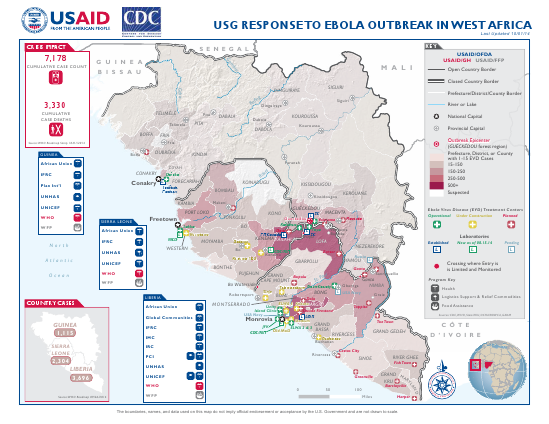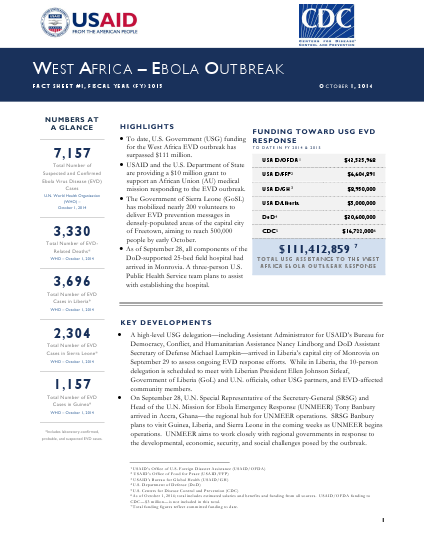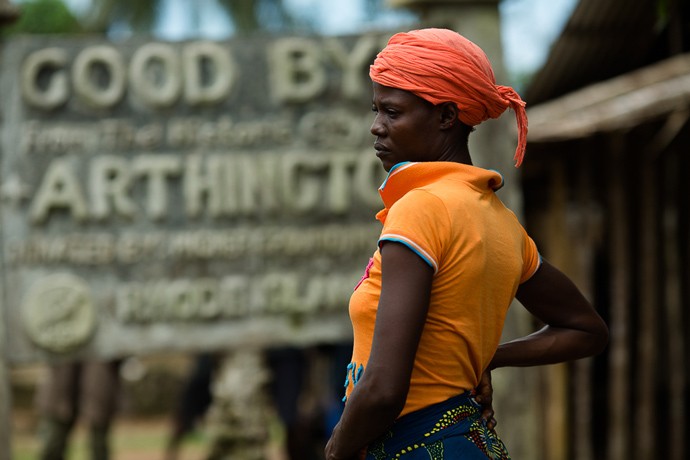Speeches Shim
October 1, 2014
HIGHLIGHTS
Ebola Response
Visit our main West Africa Ebola Outbreak page to learn more about how we're responding to the West Africa Ebola outbreak, and what you can do to help.
- To date, U.S. Government (USG) funding for the West Africa EVD outbreak has surpassed $111 million.
- USAID and the U.S. Department of State are providing a $10 million grant to support an African Union (AU) medical mission responding to the EVD outbreak.
- The Government of Sierra Leone (GoSL) has mobilized nearly 200 volunteers to deliver EVD prevention messages in densely-populated areas of the capital city of Freetown, aiming to reach 500,000 people by early October.
- As of September 28, all components of the DoD-supported 25-bed field hospital had arrived in Monrovia. A three-person U.S. Public Health Service team plans to assist with establishing the hospital.
KEY DEVELOPMENTS
A high-level USG delegation—including Assistant Administrator for USAID’s Bureau for Democracy, Conflict, and Humanitarian Assistance Nancy Lindborg and DoD Assistant Secretary of Defense Michael Lumpkin—arrived in Liberia’s capital city of Monrovia on September 29 to assess ongoing EVD response efforts. While in Liberia, the 10-person delegation is scheduled to meet with Liberian President Ellen Johnson Sirleaf, Government of Liberia (GoL) and U.N. officials, other USG partners, and EVD-affected community members.
On September 28, U.N. Special Representative of the Secretary-General (SRSG) and Head of the U.N. Mission for Ebola Emergency Response (UNMEER) Tony Banbury arrived in Accra, Ghana—the regional hub for UNMEER operations. SRSG Banbury plans to visit Guinea, Liberia, and Sierra Leone in the coming weeks as UNMEER begins operations. UNMEER aims to work closely with regional governments in response to the developmental, economic, security, and social challenges posed by the outbreak.
CURRENT SITUATION
West Africa - Ebola Outbreak - Fact Sheet #1 (FY 15) ![]() (pdf - 252k)
(pdf - 252k)
USAID and the U.S. Department of State formalized a $10 million grant—approximately $5 million from each—for the AU Commission to support the deployment of more than 100 health care workers to assist with the ongoing EVD outbreak response. With the USG funding, health personnel from AU member states will receive EVD preparedness training and deployment assistance. The AU Support to Ebola Outbreak in West Africa (ASEOWA) mission will augment on-going efforts to control the outbreak. ASEOWA personnel will directly respond to medical needs in Guinea, Liberia, and Sierra Leone in close cooperation with governments in affected nations, the USAID-led Disaster Assistance Response Team (DART), CDC, and other international responders.
CDC has announced an introductory training course for licensed clinicians—including nurses, physicians, and other health care providers—intending to deploy to affected countries to support clinical care in ETUs. CDC plans to provide multiple offerings of the three-day course in the U.S. for at least three months, beginning the first week of October. The primary purpose of the course is to ensure that clinicians intending to provide medical care to EVD patients have sufficient knowledge of the disease and its transmission routes to work safely and efficiently in a well-designed ETU.
The U.N. Children’s Fund (UNICEF) reported on September 30 that the EVD outbreak has orphaned at least 3,700 children in Guinea, Liberia, and Sierra Leone. UNICEF also noted that many of the children face stigma and rejection from extended families and communities due to parents dying from EVD. With rising case numbers, the UNICEF report found that the number of orphaned children could double by mid-October.
Since the beginning of August, CDC has worked with airlines, airports, ministries of health, and other partners in EVD-affected countries to provide technical assistance for airport exit screenings and travel restrictions. Exit screening is recommended in countries with EVD outbreaks because the benefit of screening for illness and exposures is much greater when conducted at or near the source of the outbreak. Successful exit screening at the source lessens the need for entry screening in other countries. Further, a well-run exit screening system also aims to increase the confidence of travelers, airline crews, and airline management, allowing affected-counties to continue receiving goods, people, and services via ports.
Liberia
The GoL national-level emergency operation center (EOC) became operational on September 25 in Monrovia, Liberia. USG and U.N. staff continue to support the GoL to increase staffing and integrate effective incident command structures in the EOC, which will coordinate the GoL response to the EVD outbreak.
How Can I Help?
Qualified medical professionals: Learn how you can volunteer to help with the Ebola outbreak
DoD technicians completed mobile laboratory site assessments in recent days near the Bong ETU and at the Island Clinic ETU in Monrovia. Thereafter, six additional DoD technicians and the two mobile laboratories arrived on September 28. DoD anticipates starting specimen testing in early October. The two additional laboratories will provide quick testing capabilities for ETUs at Bong and Island Clinic. Rapid testing is vital to remove negative cases from facilities and open beds for other suspected cases.
CDC continues to work with WHO and Bong County health officials to open an Ebola community care center (CCC)—a site where suspected or confirmed cases of EVD receive care from a designated family member while awaiting referral to an ETU. CDC, county health officials, and WHO are developing standard operating procedures and position descriptions, as well as identifying and training staff, for the CCC. CDC anticipates that the Bong CCC may open during the week of September 28 but notes that a continuous supply of personal protective equipment (PPE) remains critical to operationalize the facility. CDC likewise continues engaging with UNICEF to identify additional CCC sites around Liberia to provide additional bed space to isolate suspected cases.
On September 29, CDC deployed four additional public health experts to Bomi, Bong, and Margibi counties to assist with EVD prevention, treatment, and infection control efforts. Two CDC personnel will conduct contact tracing and surveillance activities in Bong. Another CDC staff member will support response efforts in Bomi, including site evaluations for potential CCCs and ETUs. The fourth CDC expert will continue community outreach, epidemiologic support, and other EVD response-related activities in Margibi County—one of the most affected counties in Liberia.
A CDC health promotion expert led a seminar with 25 Muslim youth leaders at the U.S. Embassy in Monrovia on September 24. The two-hour question-and-answer session provided participants with messaging strategies to increase EVD awareness among Muslim communities. As a result, the CDC expert was invited by the Liberian Media Center’s Radio Al Falaah to provide an EVD presentation to the Muslim community.
On September 26, DART members visited Margibi County’s capital city of Kakata to oversee the delivery of USAID/OFDA-funded commodities—including 100 rolls of plastic sheeting and 80 cots—to Save the Children’s ETU site, which is currently under construction. In Kakata, DART members also toured C.H. Rennie Hospital and observed the Margibi County EVD EOC and call center—both housed within the hospital campus. The hospital reopened during the week of September 22 following its recent closure due to a rise in EVD-related health care worker deaths. In recent weeks, health actors implemented infection control measures—including building a barrier around the hospital campus and a triage area near the entrance to the hospital—in an effort to encourage health care workers to return to work and decrease transmission risk.
Sierra Leone
The GoSL placed Bombali, Moyamba, and Port Loko districts—which have a total population of approximately 1.2 million people, according to international media—under quarantine on September 25, raising the total number of districts quarantined in Sierra Leone to five. The GoSL has maintained quarantines around Kailahun and Kenema districts since early August.
On September 27, CDC and DART staff accompanied U.S. Chargé d’Affaires Kathleen FitzGibbon to the site of a new ETU in Sierra Leone’s Port Loko District. As of September 24, health officials had confirmed 209 cases of EVD in Port Loko—one of the most EVD-affected areas in Sierra Leone. The DART is working with the private sector to support the construction of a 50-bed ETU.
The Government of China (GoC) delivered a second mobile laboratory to Sierra Leone on September 25, according to the U.N. The laboratory arrived as many suspected cases await testing following the September 19–21 house-to-house campaign, which helped identify at least 150 suspected EVD cases. GoC previously delivered a mobile laboratory on September 17, along with a 59-member medical team.
UNICEF has reported a sufficient pipeline of PPE in Sierra Leone for the next two months, as well as logistics capabilities to manage the supply chain, according to the DART. UNICEF is currently distributing two weeks’ worth of PPE supplies to each of Sierra Leone’s 12 districts.
Guinea
CDC is working closely with the Guinean Ministry of Health to strengthen contact tracing efforts in the capital city of Conakry. Contact tracing efforts supported by CDC have recently identified cases in Conakry among known contacts, indicating that contact tracing efficacy in Conakry is improving.
Health actors in Guinea report that community resistance to EVD response efforts continues to inhibit the implementation of comprehensive contact tracing activities and other EVD-related humanitarian assistance, particularly in Macenta, Nzérékoré, and Yamou prefectures. Insecurity recently prevented a group of medical students—originally from Guékédou, Macenta, and Yomou prefectures—from returning to their areas of origin to conduct EVD awareness activities, according to the Government of Guinea (GoG) national EVD crisis coordination group. International media also report that community members attacked a group of six Red Cross volunteers attempting to safely collect the body of a deceased person in Forecariah town, western Guinea, on September 23; the attack resulted in at least one injury that required hospitalization.
Between September 24 and 28, suspected EVD patients were unable to relocate from a transit center in Guinea’s Macenta Prefecture to the ETU in Guékédou Prefecture due a road blockage, according to DART reports. The number of patients in the Macenta transit center had increased from 19 to 33 cases between September 25 and 26. Although the DART reports that the situation was resolved by September 29, the increases in cases highlighted the urgent need to operationalize the planned ETU in Macenta.
Health actors continue efforts to establish four additional transit centers for EVD-affected individuals in Guinea. One transit center—located in Forécariah Prefecture—is currently under construction with GoG and U.N. support. Three additional transit centers are planned for Kérouané, Nzérékoré, and Yomou prefectures. UNICEF has committed to supporting the completed transit centers by providing ambulances and addressing the nutrition, protection, and WASH needs of suspected and confirmed EVD patients in the centers.
LOGISTICS AND RELIEF COMMODITIES
USAID/OFDA airlifted more than 2,000 rolls of plastic sheeting into Liberia on September 28. USAID/OFDA plans to transfer the plastic sheeting to a warehouse managed by the Logistics Cluster—the coordinating body for humanitarian logistics activities, comprising U.N. agencies and other stakeholders—on the grounds of the Samuel K. Doe Stadium in Monrovia. USAID/OFDA plans to consign the sheeting to actors constructing ETUs in Liberia.
On September 25, a shipment of 160 USAID/OFDA-procured tents arrived in Monrovia, and an additional 46 tents from DoD arrived on October 1. The tents will support DoD-funded ETUs in Liberia by providing storage areas for supplies and safe areas for infection control practices at ETUs.
FOOD SECURITY AND LIVELIHOODS
On September 27, the U.N. Food and Agriculture Organization, the U.N. World Food Program (WFP), and the GoL Ministry of Agriculture launched a joint mission to assess the economic and food security impact of the ongoing EVD outbreak on urban and rural populations in Liberia. In addition, the assessment results will provide guidance for future assistance to EVD-affected communities.
On September 23, WFP began delivering prepared meals and Plumpy’Nut—a ready-to-use therapeutic food product—to patients at the Guékédou ETU in Guinea. In addition, WFP is providing all patients discharged from the Guékédou ETU with a 60-day food ration upon leaving the ETU. WFP also recently began conducting general food distributions in EVD-affected communities in Guinea, according to the DART. The most recent distribution consisted of 45-day rations—including rice, oil, pulses, and salt—to families.
WFP Liberia completed food distributions to the densely-populated West Point neighborhood in Monrovia, Liberia, on September 27. A total of 48,400 beneficiaries received food in West Point, which the GoL had quarantined for nearly two weeks in August.
WFP’s immediate priority in Sierra Leone is to provide food assistance to the five quarantined districts of Bombali, Kailahun, Kenema, Moyamba, and Port Loko, as well as ETUs, areas in Freetown, and other parts of the country. In September, WFP delivered more than 1,600 metric tons of food assistance, reaching at least 205,000 people across the country. WFP continues to distribute food assistance to vulnerable communities and quarantined households following the three day house-to-house campaign in late September.
To date, USAID/FFP has provided more than $6.6 million in FY 2014 funds to support WFP’s programs in EVD-affected countries.
INTERNATIONAL RESPONSE
On October 1, the United Kingdom Secretary of State for International Development Justine Greening announced that the United Kingdom’s Department for International Development (DFID) will provide an additional £20million—$32.4 million—to support public health staff and procurement of supplies for the ongoing response in Sierra Leone. The DFID funding will also allow for additional international disease control experts to assist the GoSL. The £20million announcement comes in addition to the previously announced £100 million—$162 million—commitment from the Government of the United Kingdom to control the EVD outbreak in Sierra Leone.
Non-governmental organization Médecins Sans Frontières handed over control of a former EVD transit center site in Macenta to the Government of France (GoF) on September 24. The GoF is transforming the facility into a 60-bed ETU and reports plans to have the ETU operational by late October or early November, according to DART staff in Guinea.
CDC is consulting with WHO to increase laboratory capacity in Cote D’Ivoire, Ghana, Guinea Bissau, and Mali under a USAID cooperative agreement. CDC epidemiologists are also working with teams in Cote d’Ivoire, Ghana, and Guinea Bissau to assess and support preparedness for possible Ebola virus disease.
The EVD outbreak in Nigeria may end in the coming days, according to CDC. Nigerian officials have not reported a new case since August 31. During the outbreak period, laboratory tests confirmed 19 cases in two Nigerian states. With assistance from CDC, the Nigerian government and health actors traced approximately 900 contacts of EVD cases—all but three contacts have completed the requisite 21 days of surveillance without developing symptoms. The remaining three contacts will complete the 21-day observation period on October 2. While likely contained, the outbreak in Nigeria will only officially end once two of the 21-day observation cycles complete without a newly discovered case.
PUBLIC DONATION INFORMATION
- The most effective way people can assist relief efforts is by making cash contributions to humanitarian organizations that are conducting relief operations. A list of humanitarian organizations that are accepting cash donations for disaster responses around the world can be found at www.interaction.org.
- USAID encourages cash donations because they allow aid professionals to procure the exact items needed (often in the affected region); reduce the burden on scarce resources (such as transportation routes, staff time, and warehouse space); can be transferred very quickly and without transportation costs; support the economy of the disaster-stricken region; and ensure culturally, dietary, and environmentally appropriate assistance.
More information can be found at:
- The Center for International Disaster Information: www.cidi.org or +1.202.821.1999.
- Information on relief activities of the humanitarian community can be found at www.reliefweb.int.
USAID/OFDA bulletins appear on the USAID website at what-we-




Comment
Make a general inquiry or suggest an improvement.